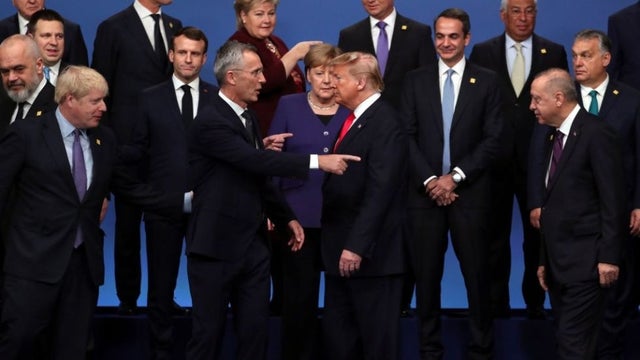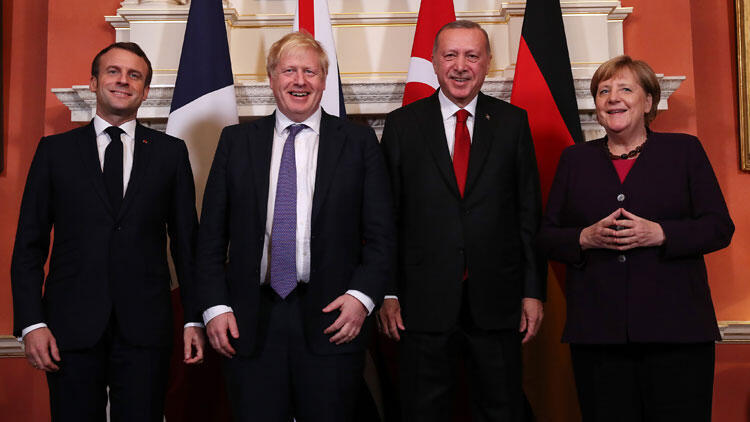
NATO leaders assemble for customary group photo at Leaders’ Meeting’ in London on Dec 5, 2019 amidst much finger-pointing and discord
The decision to “downgrade” the NATO’s historic summit meeting in London on the 70th anniversary of the alliance to a mere “Leaders’ Meeting” implied that no joint declaration or communique would need to be issued after the event. That was smart thinking.
The apprehension was that the sharp differences amongst the alliance partners on many crucial issues on the agenda all but precluded the scope for consensus decisions.
In the event, the differences became the leitmotif of the summit, thanks largely to the rift between the US President Trump and French President Emmanuel Macron just before the summit, in full public view, which in turn overshadowed almost everything else. The anti-Trump US media lobby had a field day.
However, it is apparent from the press conference by NATO secretary-general Jens Stoltenberg following the London summit that the event was far from unproductive, and, instead, as he put it, the allies took “a wide range of important decisions.” Stoltenberg highlighted the following:
- The NATO’s Readiness Initiative has been formalised whereby the allies have committed 30 battalions, 30 air squadrons, and 30 combat ships, available to NATO within 30 days;
- Space has been declared as a new operational domain for NATO (in addition to land, air, sea and cyber);
- A “new action plan” to step up the fight against terrorism;
- Commitment by allies to “rely only on secure and resilient” 5G systems for telecommunications infrastructure;
- Stepping up defence investment, with allies adding another $400 billion through next 5 years to their defence budget.
Stoltenberg said there was a “substantive discussion” regarding Russia. He explained, “We are committed to strong deterrence and defence, while remaining open to meaningful dialogue with Russia. NATO is responding to Russia’s deployment of intermediate-range, nuclear capable missiles in a defensive and coordinated way.”
There was no cutting edge in Stoltenberg’s remarks regarding Russia. It appears that Macron’s recent remarks in media interviews stressing the importance of engaging Russia in dialogue accounted for the NATO’s mellowed tone.
Equally, although China figured for the first time in a NATO summit as an agenda item for discussion, Stoltenberg paraphrased the deliberations in a non-combative way, which implies that the US couldn’t quite carry the day. To quote Stoltenberg,
“For the first time, we addressed the rise of China – both the challenges and the opportunities it poses. And the implications for our security. Leaders agreed we need to address this together as an Alliance. And that we must find ways to encourage China to participate in arms control arrangements.”
Later, during the Q&A, Stoltenberg dilated on Russia and China. He said, “Russia is our closest neighbour, our biggest neighbour, and we need to strive for a better relationship with Russia. And even if we are not able to get a better relationship with Russia in the near-term, we need to manage a difficult relationship… we need to make sure that we have predictability, transparency to avoid incidents, accidents. And if they happen, to make sure that they don’t spiral out of control and create really dangerous situations.”
Suffice to say, he chanted the old NATO mantra of “deterrence, defence and dialogue” with Russia, which presages that the more things seem to change, the more they remain the same. Clearly, Macron’s line on Russia failed to gain traction at the London summit.
It is a signal success for Washington’s transatlantic leadership that Russia continues to be cast in an enemy image. NATO has failed to respond to President Vladimir Putin’s overture in September proposing a moratorium on deployment of inter-mediate range missiles in the post-INF Treaty scenario that lies ahead.
As regards China, Stoltenberg added, “NATO has traditionally been focussed on the Soviet Union and then later on Russia. This is the first time NATO leaders had a discussion and addressed together, based on our analysis, our assessments, a discussion about both the opportunities of the rise of China, connected to the rise of China, but also the challenges. So just the idea that, now, 29 Allies addressed this issue together is an important step in the right direction.”
Stoltenberg acknowledged that China is “not a one-dimensional issue.” For, China’s rise also opens up “great economic opportunities” for NATO member countries. On the other hand, China is militarising rapidly, which calls for China’s inclusion in future arms control arrangements, although “it’s too early to be specific.”
In sum, Beijing will take note that Washington has succeeded in inserting China’s rise as a concern of the NATO. How this pans out in the years to come remains to be seen, since European countries — not only major powers like Germany or Italy and France but also the countries of central Europe — have strong business and economic interests in developing their relations with China. In the run-up to the NATO summit in London, Macron had outright rejected the idea of the western alliance casting China as an adversary.
The details on NATO’s new “action plan” on Syria are yet to emerge, but all signs are that Turkey has carried the day. President Recep Erdogan announced separately that the ‘Quad’ on Syria — France, UK, Germany, Turkey — will meet in February in Istanbul and “at least” once annually from now onward. Evidently, Turkey dug in, and, according to Erdogan, if the European countries want to play a role in the Syrian situation, they must join Turkey to help with the logistics to establish security in northern Syria.

Quadrilateral summit on Syria: French President Emmanuel Macron, UK Prime Minister Boris Johnson, Turkish President Recep Erdogan and German Chancellor Angela Merkel met on the sidelines of the NATO gathering, London
As quid pro quo for NATO acquiescing with Turkey’s occupation of regions of northern Syria, Erdogan has dropped his objection to the alliance’s (read Washington’s) deployment plan for the Baltics and Poland.
The Russian media have highlighted the theatrical happenings centred around Trump and the discord amongst the NATO allies to underscore that the alliance is in hopeless disarray and the US’ leadership role is irreversibly in decline. However, while drawing the balance sheet of the overall outcome of the London summit, Moscow won’t like the tidings.
Unsurprisingly, the Kremlin has cause to be concerned that NATO is advancing toward the Russian border and is also possibly wading deeper into the Middle East conflicts, especially Syria and Iraq (which the new “action plan” suggests.)
Most importantly, no door is opening over the crucial topic of arms control despite Moscow’s entreaties. If anything, US and NATO are complicating matters by insisting on China’s inclusion in future arms control negotiations despite Beijing’s total rejection of any such proposal.
France has been receptive to the idea of a moratorium on future deployments of intermediate range missiles in Europe pending a new agreement to replace the defunct INF Treaty, but the NATO summit has altogether cold-shouldered the idea. (Read the transcript of Macron’s joint press conference with Stoltenberg in Paris on November 28, 2019.)
On the whole, we see here a familiar pattern: the NATO alliance appears to be at an inflection point and apocalyptic predictions are galore but in the final analysis, the US writ runs large. Stoltenberg put things neatly in a historical context when he said, “there has been disagreements in NATO as long as this Alliance has existed… We have to remember that we have had disagreements in this Alliance since the Suez Crisis in the 1950s, to the Iraq War in 2003, and many more.”
